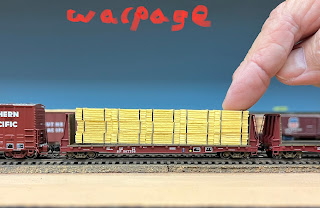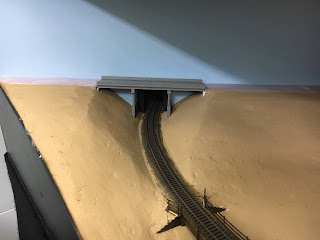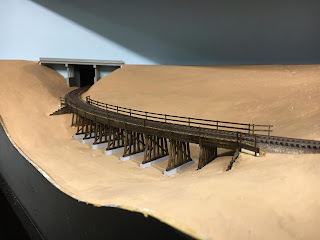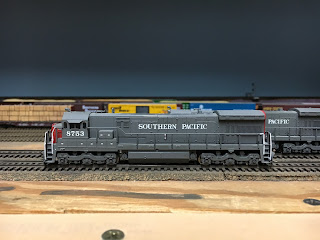Espee Oregon Division
Image above captured on the upper deck of the layout where scenery has progressed to some extent...
Shot with Olympus C-750
Welcome to the SP Oregon Division!
An N Scale RR depicting the good old days along "The Friendly".
Shot with Olympus C-750
Welcome to the SP Oregon Division!
An N Scale RR depicting the good old days along "The Friendly".
Sunday, January 28, 2024
Thursday, August 13, 2020
Lumber Mill Structures
I have reworked some of the trackage for my Pope and Talbot lumber mill at Oakridge. There are now two tracks in the back to handle the increase of woodchip traffic that JMRI Ops (generated switchlists) needed to keep car flow moving. The track arrangement is actually closer to the original SPINS configuration this way (my only current view of what trackage looked like) Was happy to find Republic Locomotive Works still offered their (laser) woodchip loader that I needed to have a matching pair.
Still begging for some stain
Still begging for some stain
I also picked up one of their bin loaders for my planned fleet of chip truck haulers (Hello, Trainworx?). This was another laser wood kit that I still have to add the ladders onto, but its got a coat of green paint (since this shot) and getting close to completion.
I also relocated a couple other tracks which made more room for placement of my loading warehouse kitbash. It was a combination of two Bingen kits from Reiten Models (well executed laser wood kit).
The mill property fills a corner that was landscaped with hardshell scenery. It has recently had the stark white plaster covered with some ground color (ha, it could be 20 years old at this point). I relocated the Walthers lumber mill (another unfinished kitbash) from where the warehouse sits more to the front since its footprint wasnt playing nice for operator access (I wish it had been more feasible to invert it the opposite configuration). Eventually there will be an array of pneumatic tubes blowing sawdust to all the loaders and the slash burner. Pondering where to cut in a service road as the whole plant is currently land locked...
Wednesday, August 12, 2020
Hampton Bridge
SP’s Willamette river crossing at the tail of Lookout Point Reservoir was via three through truss sections (basically) in the middle of three plate girder sections.
Ron Harr image:
Space on the layout here only permitted half that, with one thru truss and a plate girder on each side of that. It was hard for me to follow through on construction due to the model being so condensed, but I continued to persevere through with an attempt to Espee-ize the more prominent components.
For construction, minor modifications to the Atlas (early style) plate girder bridges entailed raising the roadbed, and adding gussets on the inside of the plate girders. I modified the Atlas (late version) thru truss bridge from an open deck to a ballasted deck, and added handrailing on both sides.
I also reworked the shape of the portal openings, which regained lost clearance from the ballasted deck conversion. Other mods included adding plates where the bridge sections are connected together, and Micro Engineering cast metal bridge feet.
This bridge is part of the overall scene that includes the west end of Hampton siding, an important addition to operations of the layout. The opening behind the bridge is to help crews view train clearances and signal indications from opposing sides. Eventually a tree line will mostly obscure the opening in an effort to keep the scene fluid.
I still need to modify the styrene bridge piers that Art built to accept the offset foot patterns, and paint the overall structure, then ballast will go in after the ground cover.
Tuesday, August 11, 2020
Eugene Yard Structures
With scenery having progressed through the yard area now, I have begun working on some related structures. The bigger projects to come will be the engine house and sand towers around the diesel service area. Meanwhile I have a few of the DeLuxe office / maintenance sheds, and a BLMA yard office filling some open space, but needed more structures to bring things alive. So I pulled out a couple brass Alkem yard light tower kits that had been sitting in a box for years. They arent perfect for what Espee had in this yard, but I was ok with them for now until something better comes along (or I want to take the time to scratchbuild new top sections). It was a bit of a challenge for me in getting the tower sections bent. I cobbled together some straight edges and clamps to hold things square while I proceeded through the bends, but felt uneasy about making the wrong move due to lack of proper tools.
Luckily things went well, and the rest of the project fell together pretty smoothly. I soldered the larger sections that were readily accessible and used ACC for assembly of the finer details. I built two of these kits together in an effort to be more productive with the assembly process. The lamp holders still need to be bent into shape, and then they will receive some black paint. They each have a home on opposing ends of the yard.
While I had sharpened my skills with these kits, it was a good time to drag out a pair of old brass yard tower kits I had from Traincat. These were a close match to what was on Espee’s property back in the day.
With these kits being a bit more complicated, I decided to get a 3-1/2” metal seamer tool from Harbor Freight, to ensure each bend was sharp and square. See link Hand Seamer. I would have preferred a few more line up keys on some steps of the overall kit, but they were fun projects to build otherwise.
I have all the glass cut out and ready for Alclad tinting, and I recently picked up the Vallejo paint colors for both these projects.
East end Eugene Yard
You can barely see the other family members at the opposite end of the yard.
Monday, August 10, 2020
Scenery Progress
The layout has been neglected scenery wise for far too long. I just seemed to get stuck in a rut daunted by all the rough scenery everywhere, and couldnt seem to make any progress. Art offered to help out, and over a number of visits we got a large swath of foam base contouring done with his hot knives (before the covid hit). Thanks Art! I have been progressing with renewed enthusiasm ever since. One of the main reasons I switched from hardshell plaster to the extruded foam was to make it easier for planting trees. Even using silicone caulk in between blocks was of concern in this regard, so I used Loctite expanding foam in a can where possible. Most minor carving was done with a knife, and final contouring was done with rough and med grades of sandpaper. Minimal filling was also done with Sculptamold and Dap lightweight spackle.
Basic scenery has finally made completion around both decks of the layout including a coat of earth color tone. No more white plaster or pink foam showing anywhere... but still lots of scenery work to do. I find myself falling back in my old ways from the construction industry, where everything needs to be done in a production line mentality for efficiency. So part of the basic scenes need to be completed before I want to proceed with ground cover. This had me working on a number of bridge projects, the wood trestle, a through truss / plate girder bridge (that post is in draft), and three (of four) highway overpasses. The highway overpasses were the last major scenic hurdle in completing the basic scenery. All are Rix kits with the ends slightly modified to adapt better to my abutment configurations, and are near ready for paint. The current state of bridge progress finally brings to light my original plans on coping with entry into the helix, and the return loop. Original construction had the track entering the helix with the ground foam extending on the opposite side of the backdrop, with the intent of lighting the opposing side, but I have since retracted on feeling there was a need over how it has evolved at this point. I used a light black paint under the bridges to fill in between the bridge piers adjacent to the portholes as needed. I dont find it as offensive as I once thought it would be having the track disappear into carefully placed blackness under the bridge(s). Contouring the scenery to work with these was a bit of a scenic hurdle for me, but I can finally see what I had originally designed over 20 years ago (sic)!
This is the entry into the helix on the lower deck that had stumped my enthusiasm for years
And where it has progressed to so far (I am not liking how tall the concrete supports are and will have to partially block their view in hopes of masking them a bit...)
Glenwood Blvd (cheating a bit) will run the length of the backdrop here, behind the trees/foliage. There are actually two bridges I needed to install to deal with the backdrop.
Before
Early overall shot of the return loop
The Supertrees are itchin to find a home
Get er done already...
And where it has progressed to so far (I am not liking how tall the concrete supports are and will have to partially block their view in hopes of masking them a bit...)
Glenwood Blvd (cheating a bit) will run the length of the backdrop here, behind the trees/foliage. There are actually two bridges I needed to install to deal with the backdrop.
Before
After
And the other overpass in back (needs a bit more after lookin at that shot)
Almost ready to pave the road and add ground cover
The Supertrees are itchin to find a home
Get er done already...
Sunday, August 9, 2020
Ballasted Deck Trestle
The bridge at Springfield Jct is an unknown structure to most, that crosses a mostly dry wash. I needed it to break up the bland scene of thick trees/foliage that will disguise the Siskiyou Sub actually being a stub track. On all my previous bridge builds I had cut out the full length of plywood roadbed when the time came to actually install the bridge. It was always a pain to cut, and without damaging anything. This time I wanted to preserve the integrity of the track already in place, and I tried a different method. Art helped me thin down the existing plywood layers from underneath with an oscillating tool. Then I used a combination of extruded foam and Sculptamold to rough in the scene.
The mockup:
I used SP Common Standards to figure construction and lumber standards. I ordered the scale lumber from Kappler, and used a Minwax walnut stain marker to represent the look of creosote. I built up a quick template to mass produce the bents, and another for the end railings as they ended up being tedious to build (then had to do them all twice due to measuring error).
The deck/handrail sections were glued with contact cement to allow time to position them. I realized halfway through the project that the prototype had raised the ballast at some point and cut the wood railings, replacing them with unistrut and cables. I ended up installing the wood railings on mine as I much preferred the original look, even though I still had to move forward with the raised deck. More extruded foam was used to fill in the large gaps below the timber bulkheads, to help calculate the length of the shorter bents, while preserving the needed slope of the bank. The wash will get an extra thick layer of dirt to basically hide all but a few of the concrete foundations. This is the only wood bridge I have built, and adds to the variety of different bridge types on the layout.
Saturday, August 8, 2020
LokSound Decoder Projects
The number of locos in the sound fleet continues to grow. I am up to seven units with ESU LokSound decoders now. All new sound installs have been getting the 73100 Select Direct Micro with a 9x16 speaker/enclosure. Not sure what Im going to do with the loss of their hardwired short board going to the Next18 connector, but I have been able to get the 73100 board into all my needed six axle conversions... so far (Hello ESU?). With the size of the active fleet making it difficult to put sound in all units, the short term goal has been to at least get one sound unit in each lashup. Typically I run the sound unit as second in consist so the overall sound is coming from the “train” rather than just the lead unit, but really they all Need sound. As a result I have not been taking the time to complete the full SP light packages as on some before, but am planning eventually to finish the fleet in one mass production line someday... The easiest install has been the IM tunnel motors with basically a plug and play install, vs a couple most difficult old school Kato units that I had to do more grinding on the frame halves, to fit the board above/between the motor saddles. Just amazing what a jump in quality these are from my first Dgtrx sound installs, as these all run and sound just great. I was thinking I would have to add more capacitors to keep all these from cutting out when I first started, but I have not had any problems as long as I keep to the normal layout ops cleaning regimen. I have been wiring the power feeds a bit different in an effort to keep cutout risk down to a minimum.
A 73100 specimen ready for implant into an Atlas SD9
How the above looks after install (power feed routing seen adjacent to speaker)
Results on a Kato SD40’s Guts
The Kato U33C Grind (similar process on the SD40 also)
The tightest fit due to caps has been on the U33C
One of my old favorites, especially now with its FDL-16 chug
Subscribe to:
Comments (Atom)


































